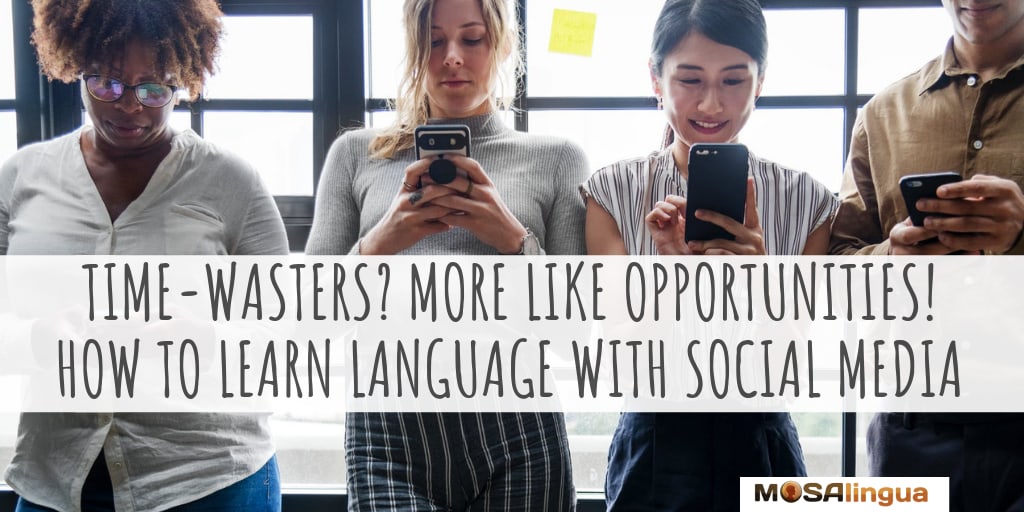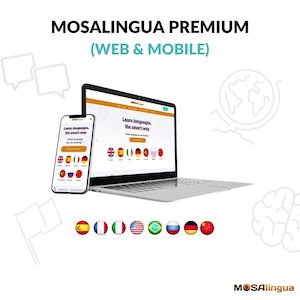This article is for everyone out there who “doesn’t have time to learn a new language.” Well, if you’re anything like me, or like 99% of the people I know, you probably spend a lot of time on Instagram, Facebook and/or Twitter. Recent studies have shown that people spend an average of 2 hours a day on social media (Americans are slightly above average, at a whopping 2 hours and 6 minutes). Have you ever wondered how much time you’re losing to social media every day? If not, it may not even be worth worrying about… Today, we’re talking about how to make this “lost time” work in favor of your language learning. Keep reading to find out how to learn a language with social media.

Here at MosaLingua, we’re always looking for ways to make language learning more fun. We also like convincing people that it isn’t about “having the time to learn a new language,” it’s about making the time. So, rather than depriving yourself of the pleasure of time-wasters (i.e. spending hours and hours on social media!), try turning them into something interactive and productive for your language learning. Need a tip? We have not just one, but six.
6 Ways to Learn a Language with Social Media
1. Subscribe to people (or pages) who speak the language you’ve chosen
To learn a language with social media, start by following people who speak the language you’d like to learn. Whether that’s on Facebook, Instagram, YouTube, or Twitter… it doesn’t matter. And of course, try to interact with them.
It’s 100% free, and your brain already sees this activity as a habit. It’s already a part of your day-to-day life, right? (Don’t lie, we’ve seen the stats.) So, you can just do what you’re used to doing, but in the language you are learning. Making small changes like this can have a huge impact on your language skills. Without even realizing it, you’re creating a language immersion environment.
You can still keep up to date on fishing, baking, yoga, or whatever other hobbies or subjects you’re interested in. But this way, you’ll improve your language skills at the same time. And remember: don’t be shy. The key is to interact so that your learning experience is active, not passive. So comment on posts, share them, and talk about them with your friends!
2. Follow the experts and other language enthusiasts
As well as natives and non-language specialists, you can also follow people who teach the language, or even polyglots who speak it. We’re talking about people like Luca Lampariello, Benny Lewis or even our own MosaLingua accounts on Twitter, Facebook and Instagram. You’ll get tons of advice and learning tips from the members of our team, language enthusiasts, or any other polyglot who is active on social media. YouTube is a great platform for this because you can work on your listening comprehension skills while you learn.
Gone are the days when you had to sit through boring language classes. The world is your language class! Pick a “teacher” you like, and who publishes videos about what you want to learn. Don’t feel like learning grammar quite yet? Skip those videos, and focus more on conversation skills or listening practice. Was your high school English teacher British, but you’d like to learn an American accent? There are tons of teachers to choose from.
We’ve put together several lists of YouTube channels that publish good content about language learning. If you’re learning French, check out these five channels. If Italian is your target language, here are 8 of our favorite YouTubers who teach it. Studying Portuguese for your next beach vacation? Practice with these channels. And if you’re looking to learn English quickly, we recommend these 5 YouTubers in particular.
3. Join language groups on Facebook
If Facebook is more your cup of tea, there are groups about language learning there, too. Join as many groups as possible. This way, every time you check your phone, you’ll find one or two new and interesting posts to read about the subject. And you’re being exposed to the language you’re learning each time you log on.
On top of that, joining language learning groups is a great way to make new online friends from all over the world. Interacting with other learners is a good way to stay motivated to learn. You can post your learning goals in a group so that the other members can hold you accountable and cheer you on. Remember to support other learners, too!
And it also opens doors for exchanging messages or even video calls with your new friends – another great way to practice the language you’re learning. This is a nice way to put your progress into perspective and see those “real results” you’ve been hoping for.
4. Watch YouTube videos in your target language
Like I said, watch whatever you want on YouTube… As long as the videos are in German, French, Russian, or whatever language you’re learning. Learning how to make pasta from scratch is way more fun (and “authentic”) if the teacher is giving instructions in Italian! And football recaps about your favorite Premier League team are more interesting in English, plus you’ll probably pick up lots of sports slang.
YouTube is also a great place to work on your pronunciation. When you subscribe to a channel that publishes videos often, you’ll have the chance to get quite familiar with one person’s particular accent. Watch their mouth and try to repeat what they say as closely as possible.
And if you’re a beginner, this site has a few features that are very helpful. Take note! Most videos have subtitles or closed captions. Just try not to rely too much on these visual aids. It’s best to try and understand as much as you can from the audio, and double check the subtitles if you are really having a hard time. You can even slow videos down to make them easier to understand. We recommend 0.75x the normal speed, but depending on where the speaker is from (hello, Spaniards!), you can even slow it down to 0.50x. Click the little gear icon to change your settings.
5. Change the language settings of your Netflix account
If you’re not that into social media but you’re more of a Netflix-and-chill person, you’re in luck! You can also use video streaming platforms to learn language. We published an article about how to learn a language by watching movies and TV series and a video specifically about how to learn languages with Netflix. But you can do more than just watch foreign-language content.
Update your Netflix profile, choosing the language you’re learning for the app itself. This way, whenever you plop down on the sofa to look for something to watch, you’ll already get exposure to your target language. Read movie and series descriptions in the language you’re learning, and watch previews. You’ll also learn basic vocab that you can use to talk about what you like to watch (look at the show’s listed genre and tags).
As you can see, you really don’t have to give up your precious downtime to learn a language. Instead, it’s way smarter to simply build new learning opportunities into your relaxation time. (I can practically hear your sighs of relief – you’re welcome!)
6. Don’t just stand in line daydreaming… Gather up all of your “wasted time” and make it count!
And, of course, try to make better use of other “wasted” time throughout your day. Besides the time you spend on social media, think about how much time do you spend on the bus on your way to school or work. Or waiting in line at the bank, or even in the waiting room at the doctor’s office. Or maybe while you’re waiting for water to boil for that delicious, fresh Italian pasta…
Instead of just sitting there, or mindlessly scrolling through your newsfeed (unless you’ve filled it with great target language content, of course) grab your cell phone, open your MosaLingua app, and learn a few new flashcards! Read a short news article in your target language. Memorize one verse of your favorite foreign-language song. There are plenty of other smart ways to turn a potential waste of time into a very productive language learning session. You just have to know how to recognize that “wasted” time and find an activity to fill it.
Video Tips from Lize
Why not practice what you just learned? Head over to YouTube (or just scroll down) and watch what Lize has to say about how to learn a language with social media. She recorded the video in English, but subtitles are available in six languages (see tip #4). Click the gear icon in the bottom right corner of the video to turn them on or to slow it down. Watch it on our YouTube channel, or right here:
Thanks for watching! Now, put Lize’s tips to use right away: subscribe to our YouTube channel, follow us on Instagram, and like our Facebook page. See you there!
Related posts:
Want to start improving your language skills today?
Start learning a new language today

Good news: we can help!
More good news: you can get started for free! Start your free trial now and for the next 15 days, take advantage of the most effective language learning method on the market!
Vocabulary flashcards, videos with subtitles, audiobooks, articles adapted to your level – with MosaLingua Premium (Web & Mobile), you’ll have access to all this and more. Get started right now. It’s free—and risk-free—to try!




Comments